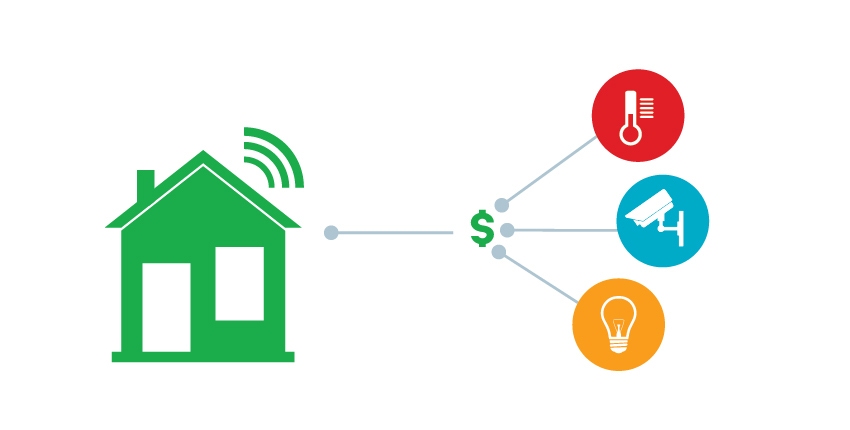The cost and value of the connected home

Are new connected home automation products worth the cost and effort?
New consumer research* reports that three in 10 Internet users now own at least one connected home device. Of those, nine in 10 would recommend the technology and 87% said these types of products made their lives easier. 44% of non-adopters listed price as their biggest impediment to purchasing connected home products.
Despite being ready for a connected home and understanding all of the benefits of home automation, consumers still wish it were less expensive to purchase and implement. But this cost perception is a little short-sighted. So we selected one product in each of the top three connected home categories contributing to the biggest drain on home energy use. Read below to see our cost break down, benefits and return on investment.
LIGHTING
Product: Basic Connected LED Light Bulbs
Value Proposition: Remote control of home lighting, easily adjust dimming and automate lighting for your schedule.
Initial Cost per Item: Approximately $15/each (on average for a 60-watt equivalent bulb)
Initial Cost per Household: The average household uses approximately 47 light bulbs so refitting an entire house would run approximately $705.00. (Standard 60-watt bulbs cost an average of $0.75 cents/bulb for a total household cost of $35.25)
Energy Savings (estimated): The average household uses approximately 47 light bulbs and the average cost for electricity is 11 cents per kilowatt-hour. Hours used per day varies pretty widely, but for purposes of this example, let’s assume that both of the homes are using 60-watt or equivalent bulbs. And the home using standard bulbs would be in use for 5 hours per day and the home using connected LED bulbs would only be in use for four hours per day.
Total Savings (estimated): Standard 60-watt bulbs typically have a bulb life of 1,000 hours while the LED bulbs can last up to 25,000. That means you’ll be buying new standard bulbs approximately every 6 months, and won’t need new LED bulbs for another 17 years.
Standard Bulbs: $566.11/year
Connected Bulbs: $90.58/year
Estimated Annual Savings: $475.53 (Over 17 years, you could save more than $8,500.)**
**Formula for calculation: kW used X Cost per kWh X Hours Used = Annual Lighting Costs
SECURITY
Product: DIY connected home security systems (sensors, motion detector, sirens), and smart door locks
Value Proposition: Protect property from intruders with remote control of home security. Sensors and detectors alert homeowners to open doors, windows and movement. Can trigger other actions like lights or sirens. Save on costly security system monthly fees.
Initial Cost per Item: Connected security systems can range from $100-$300 for basic equipment package. Smart door locks run about $200/each.
Initial Cost per Household: Assuming the average household would need 1 system and 2 locks, total estimated initial cost would be approximately $600.
Annual Savings (estimated): Traditional home security monitoring companies typically have an equipment fee in addition to a monthly monitoring fee. The average equipment cost is $100 and the average monthly fee is $20***. Over 5 years, the homeowners that chose the DIY connected home security option could save $700. Additionally, some insurance companies offer homeowners rebates on home-monitoring equipment and, in some cases, discounts on home insurance premiums. The U.S. average for homeowners insurance is $952 per year. A 10% discount for a home security system could save an additional $95/year. Interested homeowners should contact their local insurance agent to confirm specific offers.
Total Savings (estimated): Based on above estimates and assuming a 10% discount on home insurance, a homeowner could potentially save $1,175 over 5 years.
DIY Connected Security: $600/first year
Traditional Home Security: $340/first year and $240/following year
***Source: asecurelife.com
HEATING & COOLING
Product: Sensi™ Smart Thermostats
Value Proposition: Remote control the climate in your home from anywhere using an intuitive mobile app. Sensi thermostat is loaded with features such as keypad lockout, current temperature, local weather information and humidity levels. It also has seven independent day-scheduling options to make it easy and convenient to achieve the perfect level of personal comfort.
Initial Cost per Item: Some Wi-Fi thermostats can go as high as $250 and that’s just for the device. Many require an engineering degree to install and can require costly service visits. Even others charge monthly fees. (Learn more about how to choose a Wi-Fi thermostat.) Sensi thermostats have lower priced options, no monthly fees and include a free mobile app. Before you purchase, check online to see if you qualify for a rebate from your local utility provider. Some rebates are as high as $100, which could pay for the bulk of the thermostat price. Assuming an average rebate amount of $25, a new Sensi thermostat could cost approximately $100-$175 depending on the model.
Annual Savings (estimated): The amount of effort your system takes to heat and cool your home directly impacts your energy usage and your energy bill, so being connected makes it easier to reduce energy costs. Additionally, Sensi thermostats deliver precise temperature control with +/- one-degree (F) accuracy and is one of the few Wi-Fi choices that is Energy Aware Qualified®. The average annual energy bill for a typical single home is approximately $2,200****. More than half of your home energy use comes from heating and cooling your home. Since energy savings is relative to your scheduling options and geographic location, below are examples of the types of savings you could see based on the above statistics:
10% energy use reduction: $110/year
20% energy use reduction: $220/year
30% energy use reduction: $330/year
***Source: https://www.energystar.gov/products/where_does_my_money_go
Additional Savings: Just making mild adjustments to your home temperature could pay for the initial purchase price. But Sensi thermostat will also send you alerts if it senses a problem on your property, such high or low home temperatures, high humidity levels or a loss of heating and cooling. This will help you stay on top of your HVAC equipment maintenance so you can arrange for a service call before the problem gets too big and too costly.
As you can see, there is so much more to consider in a connected home than just the initial equipment price. The value can extend into year-after-year savings, increased security, optimized personal comfort and peace of mind. What are you waiting for?
*June 2015 study from Coldwell Banker Real Estate and CNET conducted by The Harris Poll
